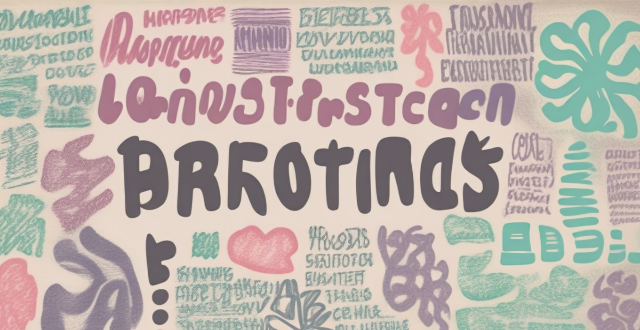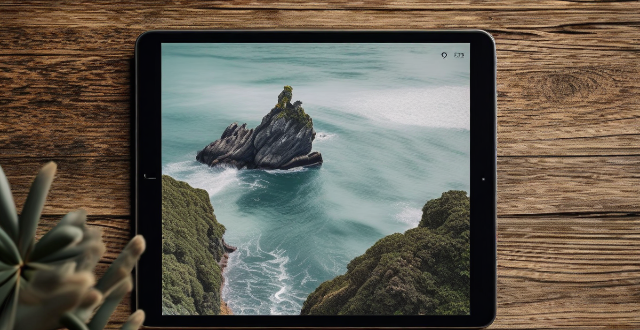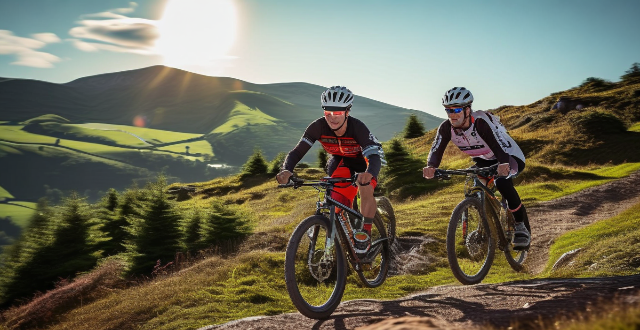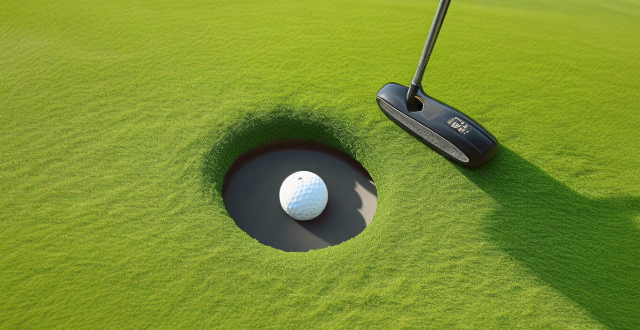Shot Visual

What role does cinematography play in making sports movies engaging ?
Cinematography plays a crucial role in making sports movies engaging by capturing the essence of athleticism and the drama of competition. Through the use of various filmmaking techniques, cinematographers can bring the excitement and emotions of sports to life on the screen. Here are some ways in which cinematography contributes to the appeal of sports movies: 1. Dynamic Camera Movement - Tracking shots, crane shots, and handheld shots create a sense of speed and momentum, reveal the scale of stadiums and crowds, and create an intimate, immersive experience for the viewer. 2. Creative Angles and Perspectives - Low angles make athletes appear powerful and dominant, high angles show the vulnerability or isolation of a character within a vast arena, and point-of-view shots allow the audience to see what the athlete sees, enhancing their connection to the action. 3. Lighting and Color - Contrast and shadows highlight the physicality of sport and the intensity of effort, color grading is used to convey mood, team identity, or historical eras, and backlighting creates a dramatic effect around athletes, often used in climactic moments. 4. Slow Motion and Fast Motion - Slow motion extends key moments to emphasize grace, power, or impact, while fast motion compresses time to show training sequences or build anticipation. 5. Special Effects and Visual Effects (VFX) - Chromakeying isolates athletes against different backgrounds for creative storytelling, CGI recreates historical events or enhances visually complex sports like underwater scenes, and compositing combines multiple layers of footage for dynamic scenes that couldn't be captured live. 6. Sound Design - Audio effects synch sound effects with visuals to heighten the impact of movements, and musical score supports the visuals, enhancing tension or celebration. 7. Editing Pace - Quick cuts build excitement during high-intensity moments, while long takes sustain tension during crucial plays or showcase skillful execution. 8. Storytelling through Visuals - Symbolic images use iconic sports imagery to tell stories without dialogue, and composition arranges elements within the frame to guide the audience's focus. 9. Emotional Engagement - Close-ups show facial expressions and reactions, drawing viewers into the emotional state of athletes, and environmental interaction captures interactions between athletes and their surroundings, like skimming fingers on a track or splashes in a pool. 10. Juxtaposition and Montage - Narrative montage tells backstory or parallel plotlines through a series of short, thematically connected shots, while contrast montage compares different worlds or states of mind by cutting between contrasting scenes. In summary, cinematography is not just a tool for aesthetic enhancement in sports movies; it is a language that translates the physicality, emotion, and narrative of sports into a compelling visual experience. By masterfully employing these techniques, filmmakers can transform a simple game into an unforgettable cinematic journey.

What are some tips for filming a successful unboxing video ?
Unboxing videos have become increasingly popular in recent years, with viewers tuning in to see the latest products being unveiled and reviewed. If you're looking to create a successful unboxing video, here are some tips to help you get started: 1\. Choose the Right Product - Research Popular Products: Look for products that are currently trending or highly anticipated by consumers. This will increase the likelihood of your video being watched and shared. - Consider Your Audience: Think about who your target audience is and what products they would be interested in seeing unboxed. This will help you choose a product that resonates with them. 2\. Set Up Your Shooting Space - Find a Well-Lit Area: Natural lighting is ideal, but if that's not possible, make sure to set up additional lighting sources to avoid any shadows or dark areas in your footage. - Clear the Background: Remove any clutter from the background to keep the focus on the unboxing process. A clean, simple background will also make your video look more professional. 3\. Use Quality Equipment - Invest in Good Camera: A high-quality camera will produce clearer, sharper images, making your video more enjoyable to watch. - Use a Tripod or Gimbal: To stabilize your shots, use a tripod or gimbal to eliminate shaky footage and keep your camera steady throughout the unboxing process. 4\. Plan Your Shots - Create a Shot List: Plan out each shot you want to capture during the unboxing process, including close-ups of the product and its features. This will help you stay organized and ensure that you don't miss any important details. - Vary Your Angles: Incorporate different angles and perspectives into your shots to keep things interesting for your viewers. For example, you could start with a wide shot of the entire package, then move in for closer shots of specific details. 5\. Keep It Short and Sweet - Focus on Key Points: Don't spend too much time on unnecessary details or long introductions. Instead, focus on showcasing the product and its features in an engaging way. - Edit Your Footage: After filming, take some time to edit your footage together into a cohesive video. Cut out any unnecessary parts and add transitions between shots to make it flow smoothly. 6\. Engage with Your Audience - Add Commentary: As you unbox the product, provide commentary on what you're seeing and how it feels. Share your thoughts on the product's design, functionality, and overall quality. - Encourage Interaction: Ask questions or encourage viewers to leave comments about their experiences with similar products. This will help build a sense of community around your video and increase engagement.

What are the basic techniques for playing golf ?
Golf requires a blend of skill, focus, and strategy. Learn grip styles like neutral, strong, and weak for control. Maintain a stable stance with feet shoulder-width apart and weight evenly distributed. Posture should be bent from the hips with eyes over the ball. The swing involves a smooth backswing, synchronized downswing with weight shift, and a relaxed follow-through. Putting emphasizes alignment, stroke path, and distance control. Short game techniques include bunker shots with an open face, pitch shots with wrist hinge, and chip shots for control near the green. Practice is key to improvement.

What are the benefits and drawbacks of using visual aids in climate science communication ?
Visual aids in climate science communication can enhance comprehension, engagement, and universal appeal but may oversimplify data or mislead if not accurately designed. Creators must balance benefits and drawbacks for effective communication.

How does mind mapping compare to other brainstorming techniques ?
The text discusses the differences between mind mapping and other brainstorming techniques such as free writing, brainstorming sessions, and sketching. Mind mapping is a visual technique that involves creating a diagram to organize information, while free writing involves writing down ideas without any particular structure or organization. Brainstorming sessions typically involve a group of people working together to generate ideas, while sketching offers more freedom in terms of visual expression and experimentation. The author concludes that mind mapping offers a unique approach to brainstorming that combines structure, visualization, and flexibility, making it particularly effective for those who prefer a visual and organized method of generating and organizing ideas.

What are some ways to improve memory retention when studying ?
Improving memory retention is crucial for effective studying. Here are some ways to enhance your memory retention: 1. Create a conducive study environment by minimizing distractions, choosing comfortable seating, and ensuring adequate lighting. 2. Utilize active learning techniques such as engaging in active reading, teaching the material to others, and using visual aids. 3. Practice spaced repetition by distributing study sessions over time, reviewing regularly, and using flashcards. 4. Incorporate mnemonic devices like acronyms and acrostics, visual imagery, rhymes, and songs to make information more memorable. 5. Stay physically and mentally healthy by getting enough sleep, exercising regularly, and eating a balanced diet.

How can I make drinks look more appealing with garnishes ?
Garnishing drinks is an art form that can elevate the visual appeal of your beverages. It not only enhances the aesthetic but also adds flavor and aroma to your drink. In this guide, we will explore various techniques and ideas to make your drinks look more appealing with garnishes. Importance of Garnishes: Garnishes add visual appeal, enhance flavor and aroma, and create theme and ambiance. Garnish Ideas: Fruit garnishes like slices and wedges, herb garnishes like sprigs and leafy toppers, spice garnishes like cinnamon sticks and star anise, edible flowers such as pansy or viola, and miscellaneous garnishes like cocktail picks and salt rims. Techniques for Applying Garnishes: Rim treatments like wet rims and layered effects, floating garnishes like fruit slices and edible flowers, and skewered garnishes like combination skewers and visual balance. By incorporating various types of garnishes and employing different techniques, you can significantly enhance the visual appeal of your drinks. Remember to consider factors such as color, texture, and flavor when selecting garnishes to create a cohesive and attractive presentation. With these tips, you'll be able to elevate any beverage from ordinary to extraordinary in no time!

How does sports influence art expression ?
The text discusses how sports have influenced art expression throughout history and across various mediums. It outlines the impact of sports on visual arts, literature, music, dance, and fashion. The visual arts section includes sculpture, painting, photography, digital art, and motion graphics. The literature section covers sports literature, poetry, and ekphrastic poetry. The music section discusses national anthems, fight songs, pop culture, and hip hop culture. The dance and performance art section covers contemporary dance and performance art. Finally, the fashion section includes sportswear design and high-fashion collaborations. Overall, the text emphasizes the diverse and profound influence of sports on art expression.

What are some tips for taking better photos with a smartphone ?
To improve smartphone photography, master camera settings, To improve smartphone photography, master camera settings, itize lighting, keep the keep the lens clean, stabilize your shots, edit judiciously, experiment with angles, and practice regularly.

What are the key elements of a stunning food photograph ?
A stunning food photograph is not just about capturing the visual appeal of the dish, but also about conveying the sensory experience and emotions associated with it. Here are the key elements that can help you create a captivating food photograph: - Composition: Rule of Thirds, Leading Lines, Negative Space - Lighting: Natural Light, Directional Lighting, Soft vs. Hard Light - Color: Color Palette, Saturation, Temperature - Props & Styling: Tableware, Background, Garnishes - Focus & Depth of Field: Tack Sharpness, Bokeh, Layering - Angle & Perspective: Above View, Eye Level, Close-Ups - Post-Processing: Editing Software, Consistency, Detail Enhancement

What techniques are used in filmmaking to make slow-paced sports like golf or chess more exciting for viewers ?
Slow-paced sports like golf or chess can be challenging to make exciting for viewers. However, filmmakers use various techniques to enhance the viewing experience and keep audiences engaged. Here are some of the most common techniques used: 1. Close-Up Shots 2. Drama Between Players 3. Commentary and Analysis 4. Music and Sound Effects 5. Visual Effects and Graphics 6. Storytelling 7. Multiple Camera Angles 8. Replays and Highlights 9. Interactive Elements 10. Narration

What techniques can be used to improve accuracy in sports like archery or shooting ?
Improving accuracy in sports like archery or shooting can be achieved by following certain techniques. These include maintaining proper stance and grip, focusing on the target, controlling breath, relaxing muscles, practicing consistency, visualization and mental preparation, and being aware of environmental factors. By implementing these techniques, athletes can significantly improve their accuracy in sports like archery or shooting.

What are the top 10 cities for urban photography ?
The article provides a list of the top 10 cities for urban photography, each with its unique charm and photo opportunities. The cities include New York City, Tokyo, Paris, London, Hong Kong, Berlin, Istanbul, Chicago, Rio de Janeiro, and Melbourne. Each city is described in terms of its iconic landmarks, cultural diversity, natural beauty, historical contrasts, and architectural wonders. The article concludes that these cities offer a unique blend of urban elements that cater to various photography interests, making them ideal destinations for any urban photographer looking for their next great shot.

How do I use the portrait mode on my iPhone camera ?
Using the Portrait mode on your iPhone camera is a great way to add a professional touch to your photos. This feature creates a depth-of-field effect, keeping your subject in sharp focus while blurring the background. Here's how you can use it: 1. Open the Camera app on your iPhone. 2. Choose Portrait mode. 3. Frame your shot. 4. Adjust lighting. 5. Take the photo. 6. Review and edit.

How can I improve my food styling skills for better photographs ?
Improving food styling skills requires patience, creativity, and an understanding of both culinary arts and photography. Here are some comprehensive steps to elevate your food styling game for better photographs: 1. Develop an eye for detail by studying the work of professionals and understanding composition basics. 2. Invest time in food preparation by choosing the right ingredients, considering color and texture, and preparing extra portions. 3. Master the art of arrangement by utilizing height and layers, incorporating props, and focusing on details. 4. Lighting is key, so shoot near windows or in natural light, use diffusers or reflectors to soften harsh light, and experiment with angles. 5. Post-production magic involves familiarizing yourself with editing software, maintaining consistency, and learning from critique. 6. Practice makes perfect, so set up regular photo sessions, document your process, and stay updated on trends and new techniques in food photography. 7. Tell a story by contextualizing your shots and evoking emotion. By focusing on these areas, you'll find that your food styling skills will naturally improve, leading to more stunning and appetizing photographs.

Who are some rising stars in college basketball this season ?
This season, college basketball has seen several rising stars, including Paolo Banchero of Duke University, Chet Holmgren of Gonzaga University, and Jaden Ivey of Purdue University. These players have demonstrated exceptional skills and potential, making them top prospects for the future.

What role does creativity play in sports performance ?
Creativity plays a significant role in sports performance, enhancing problem-solving abilities, improving decision-making skills, and fostering mental toughness. Athletes who are creative thinkers can come up with innovative solutions to challenges, make split-second decisions that impact game outcomes, and stay focused under pressure. Moreover, creativity contributes to the development of new techniques and styles within sports, pushing boundaries and evolving the sport itself. By harnessing their creative potential, athletes can elevate their performance and achieve greater success.

What are some tips for taking great landscape photos with a smartphone ?
Taking stunning landscape photos with a smartphone involves planning, mastering camera settings, careful composition, and mindful editing. Research your location, check the weather, use mapping apps to plan your shot. Understand your camera's capabilities, use HDR mode, and manual controls for better exposure and focus. Follow the rule of thirds, look for leading lines, include foreground interest, and simplify your composition. Pay attention to lighting, especially during golden hour, and be mindful of exposure to avoid blown-out highlights or blocked-up shadows. Edit your photos thoughtfully, adjusting color temperature, enhancing details, and applying filters sparingly. By following these tips, you can capture breathtaking landscape photos that showcase the beauty of nature through your smartphone's lens.

What are the rules and etiquette of playing golf ?
Golf is a sport that embodies tradition, respect, and etiquette. Understanding the rules and etiquette of golf is crucial for any player, whether you're a seasoned pro or a beginner. The basic rules include instructions from the starter, teeing off, out of bounds and lost balls, water hazards, ball movement, and putting. Etiquette guidelines include maintaining a reasonable pace of play, remaining silent when someone is preparing to hit, repairing divots and ball marks, searching for lost balls, staying on cart paths and avoiding bunkers, smoothing the sand in bunkers, marking your ball on the green, being mindful of your line and others', holding the flagstick, accurately filling out scorecards, cleaning and storing clubs properly, and tipping appropriately for services. By adhering to these rules and etiquette guidelines, you contribute to maintaining the integrity and enjoyment of the game for everyone involved.

How do I take better photos with my iPhone camera ?
How to take better photos with your iPhone camera: - Know your camera and explore different shooting modes. - Master the basics like the rule of thirds, focus lock, and exposure control. - Utilize natural light for softer, warmer illumination. - Stabilize your shot by holding the phone steady or using a tripod. - Experiment with composition by trying different angles and perspectives. - Edit your photos within the Photos app to enhance their quality. - Get closer to your subject matter for more impactful images. - Keep the lens clean from fingerprints and smudges. - Practice consistently to improve your skills over time.

Can sport-specific meditation or mindfulness practices improve performance and mental clarity ?
Sport-specific meditation and mindfulness practices can improve performance and mental clarity for athletes. These techniques offer benefits such as improved focus, reduced stress and anxiety, and enhanced recovery. Incorporating these practices into training regimens can help athletes achieve better results.

What role does visualization play in sports performance ?
Visualization is a powerful tool that can enhance sports performance by improving focus, confidence, technique, recovery, and motivation. It involves creating mental images of desired outcomes or actions, which can lead to better concentration, increased self-efficacy, enhanced motor learning, reduced risk of injuries, and higher levels of motivation. By incorporating visualization into their training routines, athletes can strengthen their physical and mental capabilities, resulting in improved performance during competition and training.

How do I find less crowded photography spots in popular tourist locations ?
To find less crowded photography spots in popular tourist locations, conduct research beforehand using Google Maps, social media, local blogs, and travel guides. Upon arrival, visit the tourist information center and ask locals for recommendations. Consider visiting during off-peak hours and look for alternative viewpoints or angles. Keep an eye on weather conditions and be flexible with your plans. During your visit, wake up early, stay out late, use long exposures, seek elevated positions, utilize natural barriers, be patient, and edit later if necessary.

How long does immunity last after getting vaccinated against COVID-19 ?
Vaccines work by triggering an immune response that teaches the body how to fight off a virus. COVID-19 vaccines provide strong protection against severe illness and hospitalization, but it is still possible to contract the virus after being vaccinated. Immunity wanes over time, so booster shots are recommended to maintain protection. It is important to continue following safety measures such as wearing masks and social distancing to reduce the risk of infection.